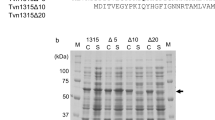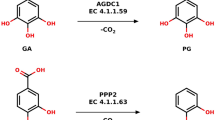Abstract
Enzyme “hexachlorocyclohexane (HCH) dehydrochlorinase LinA” mediates first step of aerobic microbial degradation of a chlorinated insecticide γ-HCH. The archetypal LinA-type1 consists of 156 amino acids that include a directly repeated hexapeptide motif GIHFAP at positions 141–146 and 148–153. Analysis of a series of LinA mutants, containing none, one, two, or three units of this repeated motif revealed that two units, as present in wild-type LinA, are required for its optimal activity and stability. Moreover, the presence of a bend in its secondary structure due to a proline residue that precedes the distal repeated unit contributes to enhanced LinA activity.



Similar content being viewed by others
References
Imai, R., Nagata, Y., Fukuda, M., Takagi, M., & Yano, K. (1991). Journal of Bacteriology, 173, 6811–6819.
Nagata, Y., Endo, R., Ito, M., Ohtsubo, Y., & Tsuda, M. (2007). Applied Microbiology and Biotechnology, 76, 741–752.
Lal, R., Pandey, G., Sharma, P., Kumari, K., Malhotra, S., Pandey, R., Raina, V., Kohler, H. P., Holliger, C., Jackson, C., et al. (2010). Microbiology and Molecular Biology Reviews, 74, 58–80.
Okai, M., Kubota, K., Fukuda, M., Nagata, Y., Nagata, K., & Tanokura, M. (2010). Journal of Molecular Biology, 403, 260–269.
Macwan, A., Javed, S., & Kumar, A. (2011). 3 Biotech, 1, 193–198.
Wu, J., Hong, Q., Sun, Y., Hong, Y., Yan, Q., & Li, S. (2007). Environmental Microbiology, 9, 2331–2340.
Kumar, M., Chaudhary, P., Dwivedi, M., Kumar, R., Paul, D., Jain, R. K., Garg, S. K., & Kumar, A. (2005). Environmental Science and Technology, 39, 4005–4011.
Boubakri, H., Beuf, M., Simonet, P., & Vogel, T. M. (2006). Gene, 375, 87–94.
Kumari, R., Subudhi, S., Suar, M., Dhingra, G., Raina, V., Dogra, C., Lal, S., van der Meer, J. R., Holliger, C., & Lal, R. (2002). Applied and Environmental Microbiology, 68, 6021–6028.
Sharma, P., Pandey, R., Kumari, K., Pandey, G., Jackson, C. J., Russell, R. J., Oakeshott, J. G., & Lal, R. (2011). PLoS One, 6, e25128.
Ohno, S. (1970). Evolution by gene duplication, 1st ed., Springer-Verlag, Berlin.
Acknowledgments
This work was supported by a grant from the Department of Biotechnology, Government of India. Ankit Macwan and Nidhi Srivastava thank the Council of Scientific and Industrial Research, India, for fellowship support.
Author information
Authors and Affiliations
Corresponding author
Rights and permissions
About this article
Cite this article
Macwan, A.S., Srivastava, N., Javed, S. et al. Role of a Repeated Hexapeptide Motif GIHFAP Near C-terminus in Assembly, Stability, and Activity of “HCH Dehydrochlorinase LinA”. Appl Biochem Biotechnol 169, 1397–1404 (2013). https://doi.org/10.1007/s12010-012-0035-8
Received:
Accepted:
Published:
Issue Date:
DOI: https://doi.org/10.1007/s12010-012-0035-8




